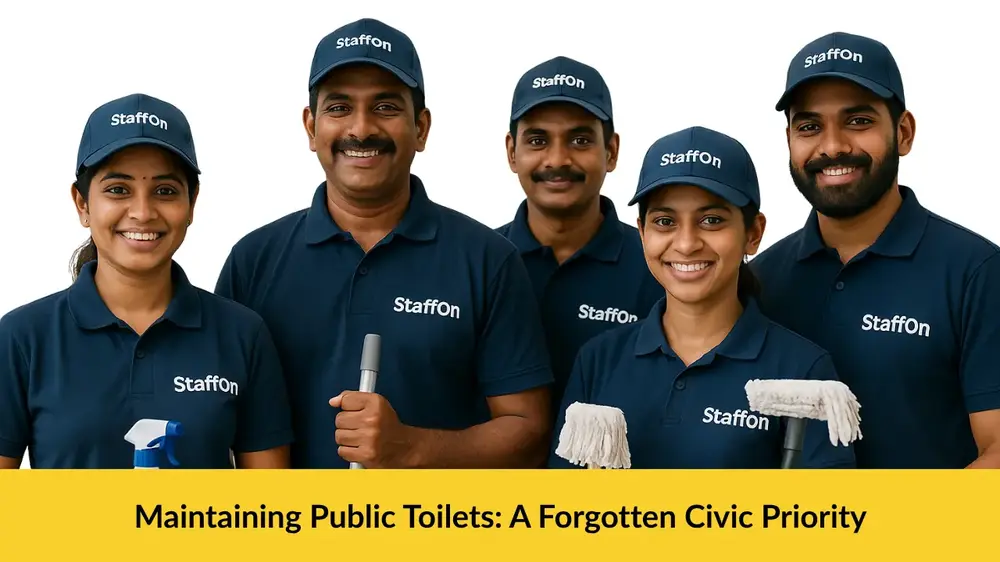Maintaining Public Toilets: A Forgotten Civic Priority
Why Maintaining Public Toilets Must Be a National Priority Maintaining public toilets is a critical yet widely neglected aspect of urban management. In cities across India—including Calicut—many public restrooms are poorly maintained, rarely cleaned, or completely unusable. This failure doesn’t just affect comfort; it creates serious public health risks, especially in crowded marketplaces, transit points, and urban slums. The importance of maintaining public toilets lies not only in providing a basic need but also in upholding dignity, safety, and sanitation for all. Whether in a modern mall or a roadside bus station, a clean, functioning toilet is a sign of respect to every citizen. The Health Impact of Not Maintaining Public Toilets When maintaining public toilets is ignored, they quickly become breeding grounds for bacteria, viruses, and pests. Public urinals and restrooms that are not cleaned daily often lead to: Diarrheal diseases Skin infections Urinary tract infections Contamination of nearby water sources This is particularly dangerous for women, elderly people, children, and those with compromised immune systems. In high-traffic areas like Calicut’s beaches, bus terminals, and railway stations, unclean toilets can cause city-wide sanitation issues. Maintaining public toilets properly is a first line of defense against widespread health problems. The Social Cost of Poor Sanitation Facilities When there are no clean public toilets, or when they’re unsafe, many people are forced to hold back or find unsanitary alternatives. This disproportionately affects women and girls, especially during menstruation or pregnancy. The lack of gender-sensitive sanitation is one of the top reasons why many avoid long commutes, traveling, or even stepping out during festivals and events. For children and senior citizens, maintaining public toilets is a public necessity, not a luxury. If access is denied or unsafe, it leads to discomfort, dehydration, or even health deterioration. Why Calicut Must Prioritize Maintaining Public Toilets Calicut is a coastal city with growing tourism, busy local markets, and a tropical climate. The mix of heat, humidity, and foot traffic makes it especially important to focus on maintaining public toilets. Even modern facilities tend to degrade quickly without structured cleaning schedules, supervision, and proper ventilation. Without intervention, even newly built toilets become unusable within weeks. How Staffon Supports Sanitation Across Calicut To effectively manage urban hygiene, municipalities must collaborate with professional services. This is where Staffon, a leading cleaning and facility management company in Calicut, comes in. Staffon helps with: Daily and deep cleaning of public toilets Disinfecting high-touch points Odor control and drain maintenance Cleaning supply management Emergency cleaning during festivals or events By outsourcing to a professional company like Staffon, local bodies ensure that public hygiene remains consistent, accountable, and cost-effective. Maintaining public toilets with trained manpower and professional equipment is far more sustainable than ad hoc cleanups. Key Areas Where Public Toilet Maintenance Is Urgently Needed 1. Transport Hubs Bus stands and railway stations are among the most-used yet most-neglected areas. Maintaining public toilets in these locations is crucial to prevent infections and improve commuter experience. 2. Public Parks and Beaches Calicut’s popular beaches and parks see thousands of visitors daily. Clean restrooms not only keep the area safe but also encourage tourism. 3. Markets and Bazaars Vendors and shoppers spend hours in crowded areas with limited facilities. Dedicated efforts to maintain public toilets in market zones can significantly enhance urban hygiene. Solutions for Maintaining Public Toilets Effectively ✅ 1. Dedicated Cleaning Teams Every toilet block must have staff on rotation with fixed schedules and responsibilities. Cleaning logs should be maintained publicly. ✅ 2. Smart Feedback Systems Installing QR codes and feedback buttons allows users to report unclean conditions immediately. ✅ 3. Community Monitoring Resident associations and shop owners can be empowered to monitor nearby toilets, ensuring maintenance is a shared responsibility. ✅ 4. Public-Private Partnerships Collaboration between city bodies and companies like Staffon ensures expertise, consistency, and results. ✅ 5. Budget Allocation and Transparency Local governments should assign dedicated budgets for maintaining public toilets and make audit reports publicly available. Women’s Safety and Sanitation: A Critical Intersection One of the gravest results of poor sanitation is the risk it poses to women’s safety. Many avoid using public restrooms due to fear of harassment, lack of lighting, or unclean conditions. A city that ignores this is indirectly pushing women out of public spaces. Maintaining public toilets with privacy, lighting, and security measures in place is essential for inclusive and equitable urban development. Accountability: Who’s Responsible for Public Toilet Maintenance? There’s often confusion between municipal corporations, contractors, and local communities about who is responsible. To solve this: Assign clear zones to specific cleaning agencies. Display maintenance agency and contact details on toilet walls. Penalize misuse and vandalism to ensure mutual respect. Ultimately, maintaining public toilets is a public–private–personal responsibility that must be taken seriously by all. Conclusion: Public Toilets Reflect Public Priorities The way a city treats its public restrooms speaks volumes about its governance, values, and people. Maintaining public toilets is not a one-time project—it’s a continuous duty. For Calicut and similar growing cities, it’s time to stop treating sanitation like an afterthought. Clean public toilets are a right, not a privilege. And with proper systems, trained partners like Staffon, and community awareness, this civic priority can finally get the attention it deserves. For more details visit https://www.jalshakti-ddws.gov.in/

